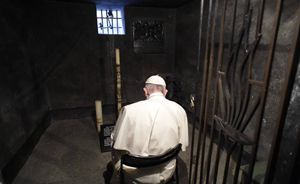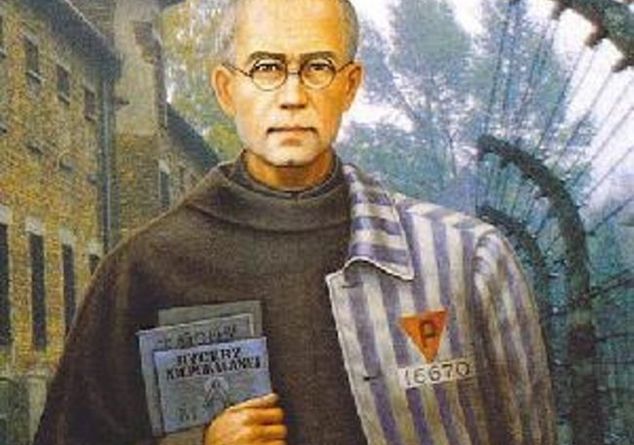If it is not the first, it is certainly among the first to have been beatified and then canonized among the victims of the Nazi concentration camps.
John Paul II He said that with his martyrdom he reported “the victory through love and faith, in a place built for the denial of faith in God and in man”. And in the homily of the canonization mass explained: “Massimiliano did not die, but” he gave his life … for his brother ” he offered himself to death for love. And in this human death there was the transparent testimony given to Christ: The testimony given in Christ to the dignity of man, to the holiness of his life and the salvific strength of death, in which the power of love is manifested “.
San Massimiliano Kolbe together with a group of deportees to Auschwitz
The brothers also enter the Franciscan order
Massimiliano Kolbe was born on January 7, 1894 in Zdunska-Wola in Poland, by fervent Christian parents; His name to the baptism was that of Raimondo. Dad Giulio, Tessile worker was a patriot who did not stand the division of Poland of the time into three parts, dominated by Russia, Germany and Austria; Of the five children had, only three, Francesco, Raimondo and Giuseppe remained alive.
Due to the scarce financial resources only the firstborn was able to attend school, while Raimondo tried to learn something through a priest and then with the country’s pharmacist; In the Austrian area, in Lopoli, the Franciscans settled, who known the Kolbe, proposed to the parents to welcome the first two older brothers in their college; They know that in the Russian area where they resided they could not have given an address and an intellectual and Christian formation to their children, due to the prevailing regime, they satisfied; Indeed, now free of the care of the children, on 9 July 1908, decided to enter themselves in the convent themselves, Giulio in the Franciscan tertiaries of Krakow, but he died killed, it is not well known if by the Germans or by the Russians, for his patriotism, while the mother Maria became Franciscan in Lepoli.
Even the third son Giuseppe after a period in a Benedictine retirement, he entered among the Franciscans. The two brothers Francesco and Raimondo from the college both passed into the Franciscan novitiate, But the first, later he came out of it by dedicating himself to the military career, taking part in the First World War and disappearing in a concentration camp.
The “militia of the Immaculate Conception”
Raimondo became Massimiliano, after the novitiate he was sent to Rome, where he remained six years, graduating in philosophy from the Gregorian University and in theology from the Seraphic College, being ordained a priest on April 28, 1918.
In his Roman stay, two particular facts took place, one about his health, one day while playing ball in the open countryside, he began to lose blood from his mouth, it was the beginning of a disease that accompanied her with ups and downs for all life. Then in those times influenced by modernism and forgers of totalitarianisms both right and left, who advanced in great steps, while Europe started to a Second World War, Massimiliano Kolbe not yet priest, founded with the permission of the superiors The “Militia of the Immaculate Conception”, religious association for the conversion of all men through Mary.
Returning to Poland in Krakow, despite being graduated with flying colors, due to bad health, he was practically unusable in teaching or preaching, not being able to speak for a long time; So with the permits of the superiors and the bishop, he dedicated himself to his invention of Marian devotion, the “militia of the Immaculate Conception”, collecting numerous adhesions among the religious of his order, professors and students of the University, professionals and peasants.

Pope Francis’ silent prayer to Auschwitz in the cell of San Massimiliano Kolbe
He founded the “City of Mary” in Warsaw and then in Japan
Alternating rest periods due to the tuberculosis that advanced, Father Kolbe founded to Krakow towards Christmas 1921, a newspaper of a few pages The Knight of the Immaculate Conception to feed the spirit and spread of the “militia“In Grodno, 600 km from Krakow, where he had been transferred, he implanted the workshop for the newspaper printing, with old machinery, but which with amazement attracted many young people, eager to share that Franciscan life and at the same time the edition of the press increased more and more.
TO Warsaw With the donation of a land by Count Lubecki, he founded “Niepokalaw”, the “City of Mary”; What happened in the following years, has some miraculous, from the first huts passed to brick buildings, from the old printing machine, it passed to modern printing and composition techniques, from the few workers to the 762 religious of ten years later, the “Knight of the Immaculate Conception” reached the edition of millions of copies, to which were added other seven periodicals.
With his ardent desire to expand his Marian movement beyond the Polish borders, always with the permission of the superiors He went to Japan, where after the first uncertainties, he was able to found the “city of Mary” in Nagasaki; On May 24, 1930 he already had a typography and the first ten thousand copies de The knight in Japanese language. In this city the orphans of Nagasaki will take refuge, after the explosion of the first atomic bomb; Collaborating with Jews, Protestants, Buddhists, he was looking for the fund of truth existing in every religion; He also opened a house in Ernakulam in India on the west coast. In order to take care of the disease, he was recalled in Poland a Niepokalaw, In the meantime, a real industrious town had become around the printing of the various periodicals, all of a high edition, with the 762 religious, there were also 127 seminarians.
Deportation, freedom and new capture
But by now the Second World War was upon us and Father Kolbe, he presaged his end and that of his work, preparing for this reason his confreres; In fact, after the invasion of 1 September 1939, the Nazis ordered the dissolution of Niepokalaw; To all the religious who started by spreading around the world, he recommended “Don’t forget love”, about 40 friars remained, who transformed the ‘city’ into a welcome place for injured, sick and refugees.
On September 19, 1939, the Germans took Father Kolbe and the other friars, bringing them to a concentration camp, from where they were unexpectedly freed on December 8th; Returning to Niepokalaw, they resumed their assistance activities For about 3,500 refugees of which 1,500 were Jews, but only a few months lasted, Then the refugees were dispersed or captured and the Kolbe himself, after a refusal to take German citizenship to save himself, given the origin of his surname, on February 17, 1941 together with four friars, he was imprisoned.
After suffering mistreatment by the prison guards, he wore a civil dress, because the Franciscan habit was very angry. On May 28 he was transferred to the extermination field in Auschwitz. His four confreres had preceded him a month earlier; He was put together with the Jews because he is a priest, with the serial number 16670 and in charge of the most humiliating works such as the transport of the cadaves to the crematorium.
An image of San Massimiliano Kolbe with the Franciscan habit
He offered to die instead of a family father
His dignity of priest and rectum man excelled among the prisoners, a witness said: “Kolbe was a prince among us.” At the end of July he was transferred to Block 14, where the prisoners were reaping in the fields; One of them managed to escape and according to the inexorable law of the field, ten prisoners were destined for the bunker of death. Father Kolbe offered himself in exchange for one of the chosen ones, a family father, his prisoner.
The despair that was granted to those poor misfortunes, was attenuated and transformed into a common prayer, led by Father Kolbe and a little at a time they resigned themselves to their fate; They died gradually and their praying voices reduced to a whisper; After 14 days not everyone had died, only four remained alive, including Father Massimiliano, then the SS decided, that since the thing went too long, to shorten their end with an injection of phenic acid; The voluntary martyr Franciscan, aimed at the arm saying “Ave Maria”. It was his last words, it was August 14, 1941.
His ashes mixed together with those of many other condemned, in the crematorium oven; Thus ended the earthly life of one of the most beautiful figures in the Franciscanism of the Polish Church. His shining martyrdom has opened the path of the Beatification, which took place on October 17, 1971 with Paul VI. On 10 October 1982 he was canonized by John Paul II.


